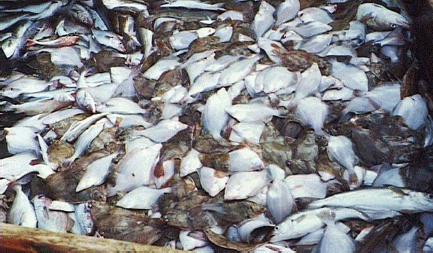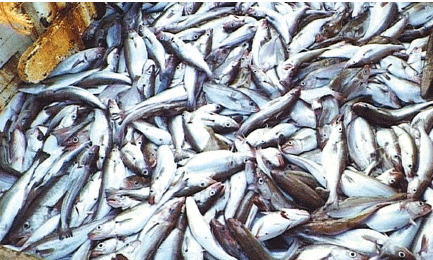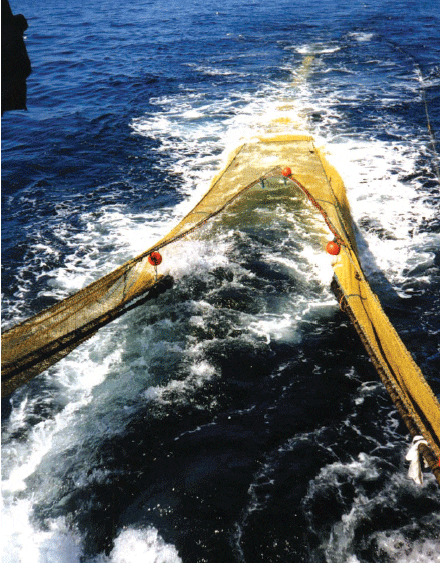We all know there are big challenges ahead for the fishing industry in stepping up efforts to reduce discards. With the increasing importance of social, economic and political factors as a big part of the issue Seafish gear trial work over the last 15 years is increasingly relevant and is now being rolled out in commercial fisheries.
In the fifth in a series of articles, Mike Montgomerie, Gear Technologist at Seafish, gives his perspective on the issue and the work Seafish, along with industry, has been doing to help develop new selective technologies and net-based fishing activities to reduce discards. In the previous article he looked at the effectiveness and fitting of square mesh panels. In this article he discusses the use of vertical and horizontal separator panels, and coverless trawls.
Types of separator panel
There are two common types of separator panel: vertical panels and horizontal panels. A vertical panel is where the trawl is divided into two or three chambers by netting panels which are laced vertically from the top panel to the bottom panel, with each chamber leading to a separate codend. Vertical panels are more likely to be used for experimental work and codend selectivity, rather than commercial fishing, and can be used commercially for splitting the catch into separate two or three codends to improve catch quality.
The more common panel however is the horizontal panel. This is where a tailored panel of netting is laced horizontally across the trawl, usually attached to the selvedges, dividing it into two chambers, one above the other, each with its own codend. This panel is usually made the same length and shape as the bottom panel, but slightly narrower.
How they work
Horizontal panels work by taking into account the behaviour of different fish species as they encounter the front of a trawl. Haddock, whiting etc tend to rise up at before falling back into the upper chamber of the trawl. Cod, flatfish, monkfish, shellfish etc do not show the same escape stimulus, and usually pass over the footrope and stay low in the trawl close to the bottom panel, and enter the lower chamber.
This behavioural separation can be naturally as accurate as getting 90% of the haddock and whiting into the top, and 95% of the cod/98% of the flats etc into the bottom chamber.
The height of the separator panel above the lower panel of the net is important. It is usually determined by two or three rope strops connecting its leading edge to the groundgear. The length of these can be adjusted to tune the catch separation and will depend on area, depth of water and time of day.
The usual starting height is approximately 750mm above the bottom panel. By separating the relatively soft fleshed haddock, whiting etc into the top codend, from the cod, ground fish, shellfish and benthic debris (bottom codend) they remain in much better condition, commanding a better price on the market.
The other advantage of this type of trawl is that the skipper could have different codend mesh sizes in each codend to better suit the Minimum Landing Size (MLS) or market requirements for the different species.
He may also have a different selective device in each chamber to improve the selectivity of each group of species. This could take the form of a 120mm diamond codend with a square mesh panel in the extension in the top chamber for the haddock and whiting, but an 80mm diamond codend on the bottom to retain the nephrops. This would have to be checked with the local fishery officers as it would result in two different cod end mesh sizes, which may infringe legislation.


Using separator panels
One of the problems with full separator panels in a commercial trawl is that with the panel wings and leading edge around the mouth of the trawl can create problems if the net is ripped or damaged.
This is the area of the trawl that suffers most damage and an extra panel of netting creates extra work and confusion when the gear is being repaired. To help alleviate this several years ago a separator panel set further back in the trawl was tested with good results.
The front of this panel was set about 5-10 metres back from the lower bosom, with its leading panel of netting inclined down to meet the lower panel of the trawl, with a gap to allow the fish to enter the lower section. Therefore the panel was far enough back to be clear of the regularly damaged belly panels, but close enough to the front of the trawl that there was still good separation of the species. As with the full length separator by making alterations to the leading edge, the panel can be tuned to maximise species separation.
In both these versions of a separator panel there is the option, although a horrendous option to most skippers, to leave either codend open if required to meet quota requirements for that particular species, while retaining species he is allowed to catch in the other codend. There are many reports available on separator panels and video clips of them operating available on the Internet, but the design really needs to be tailored to suit each individual net design.

Coverless trawl
Another selective design working on the fishs natural escape behaviour is the coverless trawl. Over the years traditional trawls have evolved with the top panel projecting further forward than the lower panel (cover or square), to prevent the escape of fish upwards, ahead of the trawl.
The coverless concept removes this overlap and makes the headline and footrope approximately the same length, so that they are directly above one another when the net is being towed, allowing fish to escape upwards. This is usually combined with a reduction in headline height to make it easier for the unwanted fish to escape.
This gear has proved to be very effective in reducing the bycatch of haddock and whiting greater than 150mm in length. It would appear that the smaller fish of these species do not rise up ahead of the trawl, but stay close to the seabed and pass into the trawl. One of the big advantages of this is type of device is that the fish are allowed to escape without ever being caught by the net, therefore there should be a 100% survival rate of the fish passing above the lowered headline.
Coverless nets have been used successfully for more than 15 years by some inshore nephrops fishermen in UK to reduce their bycatch of whiting and haddock. In many situations by reducing the bulk of fish entering the trawl there is a noticeable increase in the quality and quantity (7 10%) of nephrops retained in the trawl. It is a fairly simple process for the more able skippers to alter an existing trawl to be coverless, but it is better to get a purpose built trawl that is designed to accommodate the reduced headline height. But one word of caution. Due to the reduction in drag, as a consequence of the reduced headline height, and the freedom the net has to spread, due to the extended headline, the skipper often has to make other alterations to his overall gear setup to work a coverless trawl efficiently.
April 2012
Further Reading
|
| - | Go to our previous news item on this story by clicking here. |

